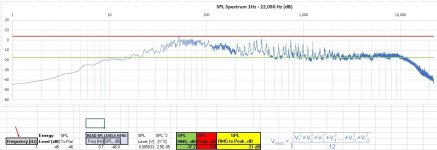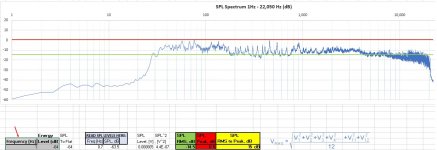Those specs are never very specific. While an amp may be rated at 20-20k, it may be down just a dB or two at 10 Hz. It is rare to find even designated low freq filters to have any kind of adequate steepness at all.
Given the looseness of tolerance on capacitors, no manufacturer would want to be embarrassed if the factory stuck in a poorish capacitor in the amp sent to the reviewers.
Only DSP can feasibly supply useful rumble filtering that doesn't impair low notes.
Again, it is lousy for sub-sonic garbage signals to make a sub-woofer cone shake but such content is not rare*. The motion of a cone on normal music is barely visible and when you see cones flapping on YouTube videos it is audio trash. Hard to see audio - google "critical flicker frequency".
Concert halls do extreme efforts to keep A/C and fire engine noises out of the hall. Older halls and recording studios may fall short.
B.
* audio aficionados know which recordings have the New York 6th Ave subway rumbling on them every few minutes...like Landowska's Goldberg Variations; frankly, I never heard the subway until my woofs went low enough
Given the looseness of tolerance on capacitors, no manufacturer would want to be embarrassed if the factory stuck in a poorish capacitor in the amp sent to the reviewers.
Only DSP can feasibly supply useful rumble filtering that doesn't impair low notes.
Again, it is lousy for sub-sonic garbage signals to make a sub-woofer cone shake but such content is not rare*. The motion of a cone on normal music is barely visible and when you see cones flapping on YouTube videos it is audio trash. Hard to see audio - google "critical flicker frequency".
Concert halls do extreme efforts to keep A/C and fire engine noises out of the hall. Older halls and recording studios may fall short.
B.
* audio aficionados know which recordings have the New York 6th Ave subway rumbling on them every few minutes...like Landowska's Goldberg Variations; frankly, I never heard the subway until my woofs went low enough
Last edited:
Those specs are never very specific. While an amp may be rated at 20-20k, it may be down just a dB or two at 10 Hz. It is rare to find even designated low freq filters to have any kind of adequate steepness at all.
Given the looseness of tolerance on capacitors, no manufacturer would want to be embarrassed if the factory stuck in a poorish capacitor in the amp sent to the reviewers.
Only DSP can feasibly supply useful rumble filtering that doesn't impair low notes.
Again, it is lousy for sub-sonic garbage signals to make a sub-woofer cone shake but such content is not rare*. The motion of a cone on normal music is barely visible and when you see cones flapping on YouTube videos it is audio trash. Hard to see audio - google "critical flicker frequency".
Concert halls do extreme efforts to keep A/C and fire engine noises out of the hall. Older halls and recording studios may fall short.
B.
* audio aficionados know which recordings have the New York 6th Ave subway rumbling on them every few minutes...like Landowska's Goldberg Variations; frankly, I never heard the subway until my woofs went low enough
Whilst I broadly agree with your comments there are arguments on both sides. In debate about subwoofers the value of 20hz is fairly arbitrary. Just because your ears can't *hear* frequencies below this it doesn't mean sub 20hz frequencies do not effect you or your environment. Take for example, a sine wave @15hz. I can see the driver oscillate but I can't *hear* anything. However, my bare feet are experiencing a strange sensation emanating from the floor and the crockery in the draining board is going nuts. Apply this notion to an explosion, a subway train, or similar - truth declares if those events happened at my location my floor and would react identically. If my speakers are incapable of producing sub audible frequencies the events would not be truly represented.
B. In my youthful, boy-racer days I desired to distress the neighbourhood with loud music but my car stereo lacked bass. I purchased a graphic equaliser - still no bass. I destroyed my parcel-shelf in order to accommodate a pair of 6 x 9's - it still sounded shitty. My entire next month's wages went on an Alpine 12" sub and amp. Nope! Just sounded louder and boxier. Finally, I read the specifications for the head unit: frequency response 100hz - 20khz.
Thanks! What I mean is how likely am I to get signals in that range? Either digital or vinyl?
Nowadays you can find music dipping below 15Hz easily:
Main Theme [Live] Hans Zimmer Live in Prague Disk 1 - 24dB Peaks, flat down to 10Hz
Aurora Hans Zimmer Live in Prague Disc 2 - 22dB Peaks - flat down to 12Hz
Dance Again Selena Gomez Rare - (-6dB at 9Hz) - 21dB Peaks - flat down to 15Hz
Vulnerable Selena Gomez Rare - (-6dB at 13Hz) - flat down to 18Hz
Captain Jack Sparrow-One Day, Hans Zimmer Live in Prague Disc 1 - flat down to 18Hz
Nice To Meet Ya (ft. Nicki Minaj) Meghan Trainor Treat Myself - flat down to 19Hz
C'mon now, how do you know it is "flat" to anything since you have no idea what the original signal was?
Perhaps you noticed output at sub-sonic frequencies using RTA. If so, can you please post your FFA Real-Time Analyses of those bits you think go to 10 Hz.
B.
Perhaps you noticed output at sub-sonic frequencies using RTA. If so, can you please post your FFA Real-Time Analyses of those bits you think go to 10 Hz.
B.
I don't see any instrument in the Zimmer that could even theoretically generate
anything close to a 10Hz fundamental.
anything close to a 10Hz fundamental.
I don't see any instrument in the Zimmer that could even theoretically generate
anything close to a 10Hz fundamental.
You are over-looking the studio air conditioning, trucks driving past, and momentary (or chronic) attacks of lunacy of the recording engineer.
BTW, readers of this thread should learn about visual "critical flicker fusion frequency" (as in movie frame rate). If you can see the cone flapping, it is likely flapping slower than 15 Hz. Ditto for the freq at which window panes and tea cups are "voiced".
(But good point you make.)
B.
Last edited:
C'mon now, how do you know it is "flat" to anything since you have no idea what the original signal was?
Perhaps you noticed output at sub-sonic frequencies using RTA. If so, can you please post your FFA Real-Time Analyses of those bits you think go to 10 Hz.
B.
I knew that might spike some interest 😉
Here is the "Dance Again Selena Gomez Rare - (-6dB at 9Hz) - 21dB Peaks - flat down to 15Hz" spectrum graph 1Hz-22kHz,
Red - peak level,
Green - RMS level
Attachments
Thanks for posting.
What is that? What is the red line? The RTA looks like no RTA on music I've ever run. Is it the loudest bit the recording engineer recorded considering the entire piece? (In which case, it demonstrates the engineer's limiter was working.)
B.
What is that? What is the red line? The RTA looks like no RTA on music I've ever run. Is it the loudest bit the recording engineer recorded considering the entire piece? (In which case, it demonstrates the engineer's limiter was working.)
B.
Last edited:
I don't see any instrument in the Zimmer that could even theoretically generate
anything close to a 10Hz fundamental.
Hans Zimmer is well known for using synthesizers.
Wikipedia: "Zimmer's score for Tony Scott's 1995 film Crimson Tide won a Grammy Award for the main theme, which makes heavy use of synthesizers in place of traditional orchestral instruments."
Here is "Main Theme [Live] Hans Zimmer Live in Prague Disc 1 - 24dB Peaks - flat down to 10Hz" spectrum 1Hz-22kHz 😛
Attachments
Thanks for posting.
What is that? What is the red line? The RTA looks like no RTA on music I've ever run. Is it the loudest bit the recording engineer recorded considering the entire piece? (In which case, it demonstrates the engineer's limiter was working.)
B.
Yes, the Red line is the highest level recorded in the whole piece.
Yes, the Red line is the highest level recorded in the whole piece.
I'm having a lot of trouble understanding you. The red line is flat, just like an amp. It seems to be no relation to an RTA of a music recording. Whatever you are posting seems rather unhelpful in the absence of a description of how you assembled those plots.
B.
Last edited:
I'm having a lot of trouble understanding you. The red line is flat, just like an amp. It seems to be no relation to an RTA of a music recording. Whatever you are posting seems rather unhelpful in the absence of a description of how you assembled those plots.
B.
That is similar to RTA max hold. It's spectrum analysis of the whole song and Blue trace shows peak levels from 1 Hz to 22050 Hz.
The Red line indicates the Peak level reached by any frequency in the whole sample, the Green line indicates the overall RMS signal value based on all frequencies Peak levels.
Last edited:
- Home
- Loudspeakers
- Subwoofers
- How worried should I be about signal < 20Hz?

![Main Theme [Live] Hans Zimmer Live in Prague Disc 1 - 24dB Peaks - flat down to 10Hz.jpg](/community/data/attachments/766/766913-5da4824c33bc4c0baa5ae4046c426d0a.jpg?hash=XaSCTDO8TA)
